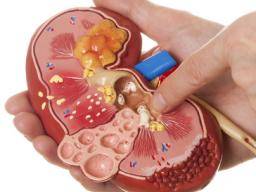
MBBS, MD-Medicine, DNB-Nephrology, ISN-ANIO CNC (USA)

The kidneys can produce fluid-filled sacs called kidney cysts. Their size can range from a few
millimeters to several centimeters, and they can be solitary or manyṣ. The majority of persons
who have kidney cysts do not exhibit any symptoms or consequences. However, certain cysts
can enlarge and result in discomfort, pain, or other issues that call for medical care. There are
several kidney cyst forms, and each has its own causes and methods of therapy.
Kidney cyst causes include:
Kidney cysts can develop for a number of causes, such as genetics, acquired illnesses, and
aging-related changes. One of the most frequent causes of kidney cysts is inherited genetic
illness, namely autosomal dominant polycystic kidney disease (ADPKD) and autosomal
recessive polycystic kidney disease (ARPKD). Cysts can develop in the kidneys and other
organs including the liver and pancreas as a result of the hereditary condition ADPKD. Children
who suffer from the rare genetic condition known as ARPKD develop kidney cysts.
Renal cell cancer, von Hippel-Lindau disease, and chronic kidney disease are further acquired
disorders that can result in kidney cysts. The scarring and destruction brought on by chronic
renal disease can lead to the development of kidney cysts. Cysts can develop in the kidneys as
a result of kidney malignancy and renal cell carcinoma. Cysts may form in the pancreas,
kidneys, and other organs as a result of the uncommon genetic disorder Von Hippel-Lindau
disease.
Treatment Approaches for Kidney Cysts:
The method used to treat kidney cysts is determined by a variety of variables, including the
cysts' size, number, and location as well as the occurrence of symptoms or consequences.
Simple kidney cysts that are tiny and don't produce any symptoms typically don't need to be
treated. However, if the cysts are huge and painful or uncomfortable, the kidney doctor can
suggest one of the following treatments:
1. Drainage: The term "drainage" refers to the process of puncturing the cyst and removing
the fluid inside of it. The patient can return home the same day after the treatment, which
is normally performed under local anesthesia. Drainage is only a short-term fix, and the
cyst could re-fill with fluid.
2. Sclerotherapy: A solution is injected into the cyst during this technique, causing it to
contract and shrink. The patient can return home the same day after this surgery, which
is likewise performed under local anesthesia. Sclerotherapy provides a more long-term
fix than drainage, however, it might not work for all cyst forms.
3. Medication: Medication may be administered to treat symptoms of kidney cysts, such as
pain or high blood pressure. Additionally, medications may be utilized to address
underlying diseases like ADPKD that lead to kidney cysts.
4. Surgery is a more intrusive option for treating kidney cysts and is usually saved for cysts that are big and produce noticeable symptoms or consequences. Surgery entails the
removal of the cyst or the cyst-containing renal tissue. Traditional open surgery or less
invasive laparoscopic surgery are also options for doing surgery.
In conclusion, kidney cysts can be prevalent and can arise from various causes, including
genetics, acquired illnesses, and aging-related changes. The method used to treat kidney cysts
is determined by a variety of variables, including the cysts' size, number, and location as well as
the occurrence of symptoms or consequences.
